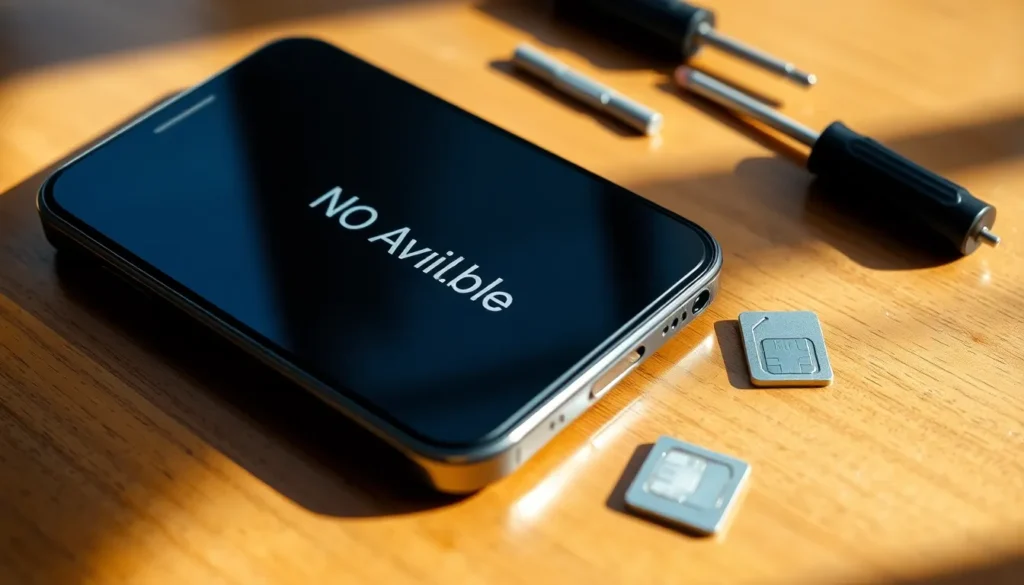Table of Contents
TogglePicture this: you’re all set to make an important call or scroll through your favorite memes, and suddenly your iPhone flashes that dreaded “No SIM Available” message. It’s like your phone just decided to go on a vacation without you. Frustrating, right?
Understanding The Issue
The “No SIM Available” message often frustrates iPhone users. Various factors contribute to this problem.
Common Causes of No SIM Available
Issues with the SIM card itself frequently trigger this message. A damaged SIM card, whether through wear or physical impact, can disrupt connectivity. Improper insertion into the SIM tray also causes problems, so ensuring it’s seated correctly is crucial. Additionally, a faulty SIM tray might lead to the phone not detecting the SIM card. Network outages during periods of maintenance or high demand can further exacerbate these connectivity issues.
Device Compatibility Problems
iPhones sometimes display the “No SIM Available” message due to compatibility issues with certain carriers. If a carrier’s SIM card lacks compatibility with the specific iPhone model, connectivity fails. Additionally, using a locked iPhone with a SIM card from an incompatible network can prompt this notification. Software version discrepancies can also interfere; outdated iOS versions may not fully support newer carrier technologies, leading to detection issues. Understanding these aspects aids in troubleshooting and finding a viable solution.
Troubleshooting Steps

Encountering the “No SIM Available” message prompts immediate action. Several effective troubleshooting steps can often restore connectivity quickly.
Restarting Your iPhone
Restarting the iPhone can resolve temporary glitches. This quick action refreshes the device’s system and network connections. To restart, press and hold the side button along with the volume button until the power slider appears. Slide it to turn off, then press the side button to power it back on. Users frequently find that this simple step resolves the “No SIM Available” issue. It’s crucial to attempt this before diving into more complex solutions.
Checking SIM Card Placement
Checking the SIM card placement is essential for ensuring proper connection. Inserting the SIM card incorrectly can trigger the error message. First, power off the iPhone to avoid any potential damage. Next, use the SIM eject tool to remove the tray. Inspect the SIM card for any visible damage and ensure it is seated correctly in the tray. After securing the SIM in place, reinserting the tray carefully can often resolve the issue. A correct placement makes a significant difference in the device’s ability to detect the SIM card.
Fixing Software Issues
Software issues can contribute to the “No SIM Available” message on an iPhone. Troubleshooting these problems often leads to successful resolutions.
Updating iOS Software
Keeping iOS updated is essential for optimal performance. An outdated version may not support newer network technologies, leading to SIM detection issues. Users can check for software updates by going to Settings, selecting General, and tapping on Software Update. If an update is available, downloading and installing it can often resolve connectivity problems. This step ensures that the device operates with the latest features and bug fixes. Regular updates also enhance overall device security.
Resetting Network Settings
Resetting network settings may restore SIM functionality. This action removes saved Wi-Fi networks, Bluetooth connections, and virtual networks. Users can initiate this process by navigating to Settings, selecting General, then tapping Transfer or Reset iPhone, and choosing Reset Network Settings. After this reset, the device restarts, prompting users to reconnect to their networks. This approach can clear conflicts that affect SIM detection and help reconnecting to carriers. Performing this reset usually resolves lingering network-related issues effectively.
Hardware Considerations
Understanding hardware components helps diagnose the “No SIM Available” message. Two crucial elements include the SIM card tray and the SIM card itself.
Inspecting The SIM Card Tray
Checking the SIM card tray is essential. A damaged tray can prevent proper contact with the SIM card. Users should look for signs of bending or breakage. Additionally, inserting the tray the wrong way can lead to connectivity issues. Cleaning the tray with a dry cloth ensures no dust or debris is causing interference. Accurate alignment when reinserting the tray is vital. Regular inspections can help avoid potential problems, keeping the device functioning effectively.
Examining The SIM Card Itself
Examining the SIM card reveals much about connectivity issues. Users should inspect for scratches or cracks on the card’s surface. Damage to the gold contacts can disrupt signals. Proper placement within the tray is necessary, as incorrect positioning leads to detection failures. Users often overlook cleaning the SIM card, which can improve performance. If the card appears damaged or worn, replacing it may be necessary. Compatibility with the device is also crucial, as using the wrong SIM type can trigger the “No SIM Available” message.
Encountering the “No SIM Available” message can be frustrating for iPhone users. By understanding the potential causes and following the outlined troubleshooting steps, users can often resolve the issue quickly. Whether it’s a simple restart or checking for software updates, these actions can restore connectivity and enhance the overall user experience.
If problems persist after trying these solutions, it may be time to consider hardware issues or consult with a professional. Staying informed about device compatibility and keeping the iPhone updated can prevent future occurrences of this annoying message.







